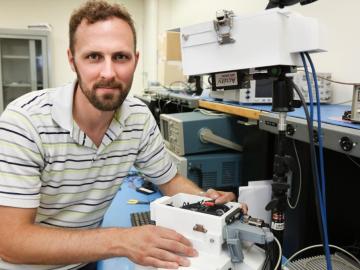
Filter News
Area of Research
- (-) Energy Science (47)
- Advanced Manufacturing (1)
- Biology and Environment (24)
- Computer Science (1)
- Electricity and Smart Grid (1)
- Functional Materials for Energy (1)
- Fusion and Fission (3)
- Fusion Energy (1)
- Materials (24)
- Materials for Computing (4)
- National Security (11)
- Neutron Science (6)
- Nuclear Science and Technology (2)
- Quantum information Science (1)
- Supercomputing (12)
News Topics
- (-) Bioenergy (14)
- (-) Cybersecurity (5)
- (-) Polymers (6)
- 3-D Printing/Advanced Manufacturing (26)
- Advanced Reactors (5)
- Artificial Intelligence (5)
- Big Data (2)
- Biology (5)
- Biomedical (4)
- Biotechnology (1)
- Buildings (13)
- Chemical Sciences (6)
- Clean Water (2)
- Composites (3)
- Computer Science (14)
- Coronavirus (9)
- Critical Materials (1)
- Energy Storage (33)
- Environment (26)
- Exascale Computing (2)
- Fossil Energy (1)
- Frontier (2)
- Fusion (1)
- Grid (17)
- High-Performance Computing (2)
- Hydropower (1)
- Isotopes (1)
- Machine Learning (5)
- Materials (10)
- Materials Science (13)
- Mathematics (1)
- Mercury (1)
- Microscopy (5)
- Molten Salt (1)
- Nanotechnology (4)
- National Security (3)
- Neutron Science (4)
- Nuclear Energy (4)
- Partnerships (5)
- Physics (1)
- Quantum Science (2)
- Security (3)
- Simulation (2)
- Space Exploration (1)
- Summit (3)
- Transportation (25)
Media Contacts

Researchers at ORNL demonstrated that sodium-ion batteries can serve as a low-cost, high performance substitute for rechargeable lithium-ion batteries commonly used in robotics, power tools, and grid-scale energy storage.

Energy storage startup SPARKZ Inc. has exclusively licensed five battery technologies from the Department of Energy’s Oak Ridge National Laboratory designed to eliminate cobalt metal in lithium-ion batteries. The advancement is aimed at accelerating the production of electric vehicles and energy storage solutions for the power grid.

Oak Ridge National Laboratory researchers created a geothermal energy storage system that could reduce peak electricity demand up to 37% in homes while helping balance grid operations.

To better determine the potential energy cost savings among connected homes, researchers at Oak Ridge National Laboratory developed a computer simulation to more accurately compare energy use on similar weather days.
Scientists studying a valuable, but vulnerable, species of poplar have identified the genetic mechanism responsible for the species’ inability to resist a pervasive and deadly disease. Their finding, published in the Proceedings of the National Academy of Sciences, could lead to more successful hybrid poplar varieties for increased biofuels and forestry production and protect native trees against infection.

Oak Ridge National Laboratory scientists have developed a crucial component for a new kind of low-cost stationary battery system utilizing common materials and designed for grid-scale electricity storage. Large, economical electricity storage systems can benefit the nation’s grid ...

As leader of the RF, Communications, and Cyber-Physical Security Group at Oak Ridge National Laboratory, Kerekes heads an accelerated lab-directed research program to build virtual models of critical infrastructure systems like the power grid that can be used to develop ways to detect and repel cyber-intrusion and to make the network resilient when disruption occurs.


